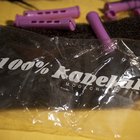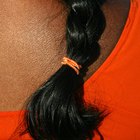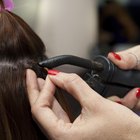
Hair extensions are the fastest-growing hairdressing service in the marketplace, according to Theresa Bullock in her book "eXtensions: The Official Guide to Hair Extensions." The service has become as popular and commonplace as coloring and perms. Women from all ethnic and economic backgrounds wear extensions.
Facts
Hair extensions and hair weaves are not the same. Extensions are the pieces of hair added during the weaving process. Weaves are the result of adding hair extensions. A person who gets a weave has hair extensions added to her hair.
Technique
A quick weave is a technique requiring the use of bonding glue. With a regular weave, extensions are sewn into braided hair. This process normally takes anywhere from 3 to 5 hours. A quick weave takes less time. The hair is wrapped tightly around the head using hair gel. Sometimes, the hair is also placed into a stocking cap. The extensions are then attached with bonding glue.
Human Hair
Human hair is sometimes used in quick weaves. It is more expensive than synthetic hair and requires the same care as the wearer’s natural hair. According to the HairExtensionGuide.com, the quality of human hair depends on its origins. Healthy hair is desirable because unhealthy hair makes extensions that are dry, brittle and difficult to manage.
Synthetic Hair
Synthetic hair is a man-made fiber that looks similar to natural hair. Quick weaves often use synthetic hair because it is inexpensive and easy to obtain. The two most widely used forms of synthetic hair are Kanekalon and Toyokalon.
Origins
People of Indian or Asian descent usually provide the hair for human hair extensions. This is the highest quality of hair available.
Related Articles

Types of Synthetic Hair

What Is Synthetic Hair Made Of?

French Braids History

Chi Hair Treatment

Who Invented Hair Weaves?

Types of Hair Treatment

Synthetic Hair Vs. Kanekalon Hair

How to Get Hair Ready for Braids

How to Curl Kanekalon

Essential Enzymes for Hair Growth

Pantene Shampoo Information

Do Hair Extensions Damage Hair?

How to Tie Micro Braids at the End

How to Make Hair Extensions Wavy

How Does a Toupee Stay On?

Pros and Cons of a Hair Weave

Ingredients in Hairfinity Vitamins

Irish Hairstyles

Chi Thermal Hair Straightener Treatment

Benefits of Soybean Oil for Hair
References
- The Hair Extension Guide
- eXtensions: The Official Guide to Hair Extensions; Theresa Bullock; 2004.
Writer Bio
Michelle Strait is a professional writer with over five years of experience. She has written for several publications, including "Writer's Digest." She has also created logic puzzles for "Penny Press Magazine." Strait graduated from the University of Alabama with a bachelor's degree in journalism and English.
Photo Credits
Image by Flickr.com, courtesy of brandi sims